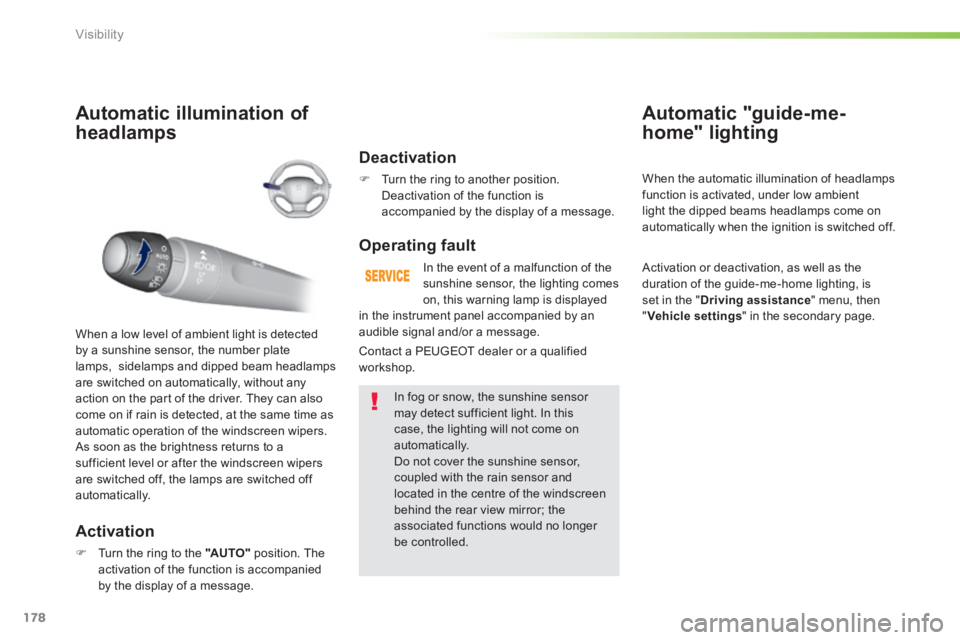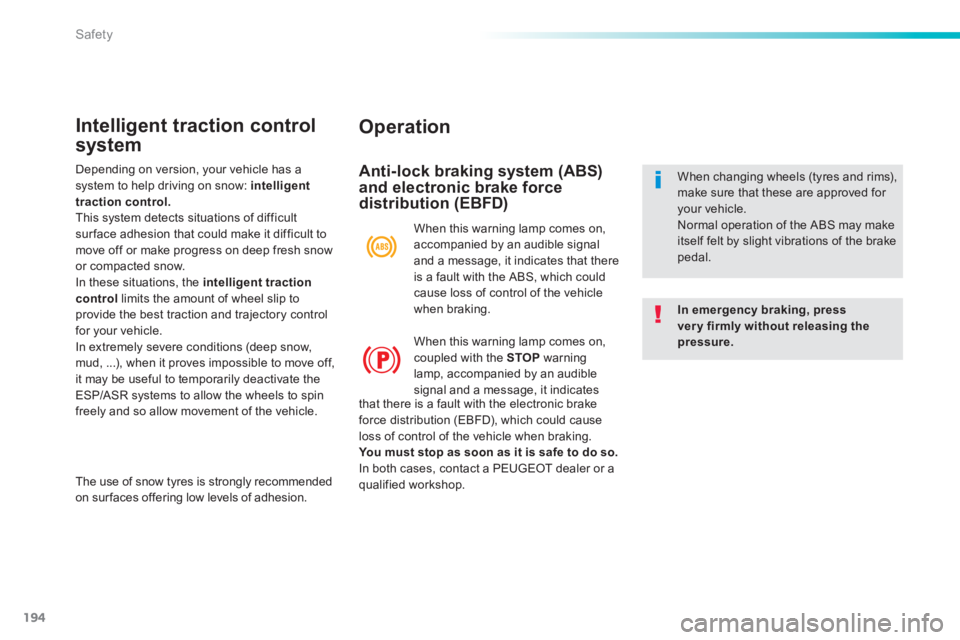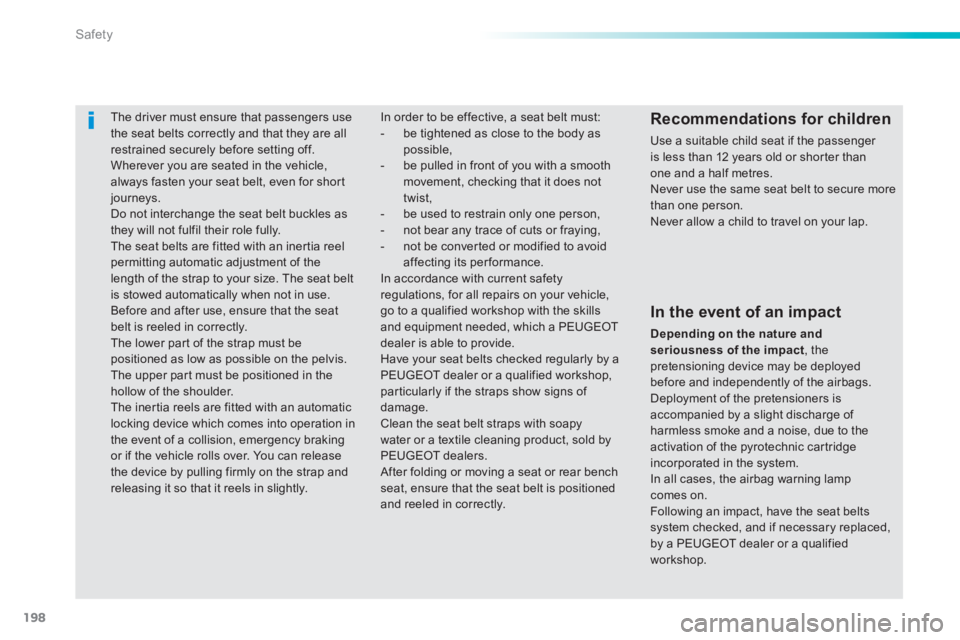2014 Peugeot 308 warning light
[x] Cancel search: warning lightPage 131 of 400

129
4
Driving
308_EN_CHAP04_CONDUITE_ED02-2013
Stop & Start
Operation
Going into engine STOP mode
The "ECO" warning lamp comes on in the instrument panel and the engine goes into standby automatically:
- With a manual gearbox , at speeds below 12 mph (20 km/h) or vehicle stationary (depending on the engine), when you place the gear lever in neutral, and you release the clutch pedal.
Never refuel with the engine in STOP mode; you must switch off the ignition with the button.
For your comfort, during parking maoeuvres, STOP mode is not available for a few seconds after coming out of reverse gear. STOP mode does not affect the functionality of the vehicle, such as for example, braking, power steering...
Special cases: STOP mode not available
STOP mode is not invoked principally when: - the vehicle is on a steep slope (up or d ow n), - the driver's door is open, - the driver's seat belt is not fastened, - the vehicle has not exceeded 6 mph (10 km/h) since the last engine start by the driver, - the electric parking brake is applied or being applied, - the engine is needed to maintain a comfortable temperature in the passenger compartment,
- demisting is active, - some special conditions (battery charge, engine temperature, braking assistance, ambient temperature...) where the engine is needed to assure control of a system.
If your vehicle is fitted with Stop & Start, a time counter calculates the time spent in STOP mode during a journey.
In this case, the "ECO" warning lamp flashes for a few seconds then goes of f. This operation is perfectly normal.
The Stop & Start system puts the engine temporarily into standby - STOP mode - during stops in the traffic (red lights, traffic jams, or other...). The engine restarts automatically - START mode - as soon as you want to move off. The restart takes place instantly, quickly and silently. Per fect for urban use, the Stop & Start system reduces fuel consumption and exhaust emissions as well as the noise level when stationary.
Stop & Start time counter
(minutes / seconds or hours / minutes)
- With an automatic gearbox , vehicle stationary, when you press the brake pedal or place the gear selector lever in position N .
It resets to zero every time the ignition is switched on.
Page 159 of 400

157
4
Driving
308_EN_CHAP04_CONDUITE_ED02-2013
The alert is given by a warning lamp which comes on in the door mirror on the side in question as soon as a vehicle - car, lorry, bicycle - is detected and the following conditions are fulfilled: - all the vehicles must be moving in the same direction, - the speed of your vehicle is between 7 and 87 mph (12 and 140 km/h), - the difference in speed between your vehicle and the other vehicles must be less than 6 mph (10 km/h), - the traffic must be flowing normally, - in the case of an overtaking manoeuvre, if this is prolonged and the vehicle being overtaken remains in the blind spot, - you are driving on a straight or slightly curved road, - your vehicle is not pulling a trailer, a caravan...
No alert will be given in the following situations: - in the presence of stationary objects (parked vehicles, barriers, street lamps, road signs...), - with vehicles moving in the opposite direction, - driving on a sinuous road or a sharp c o r n e r,
- when overtaking (or being overtaken by) a very long vehicle (lorry, coach...) which is at the same time detected at the rear in the blind spot angle and present in the driver's for ward field of vision, - in very heavy traffic: vehicles detected in front and behind are confused with a lorry or a stationary object, - when overtaking quickly.
Page 180 of 400

178
Visibility
308_EN_CHAP05_VISIBILITE_ED02-2013
Automatic illumination of
headlamps
Activation
Turn the ring to the "AUTO" position. The activation of the function is accompanied by the display of a message.
When a low level of ambient light is detected by a sunshine sensor, the number plate lamps, sidelamps and dipped beam headlamps are switched on automatically, without any action on the part of the driver. They can also come on if rain is detected, at the same time as
automatic operation of the windscreen wipers. As soon as the brightness returns to a sufficient level or after the windscreen wipers are switched off, the lamps are switched off automatically.
Deactivation
Turn the ring to another position. Deactivation of the function is accompanied by the display of a message.
Operating fault
In the event of a malfunction of the sunshine sensor, the lighting comes on, this warning lamp is displayed
In fog or snow, the sunshine sensor may detect sufficient light. In this case, the lighting will not come on automatically. Do not cover the sunshine sensor, coupled with the rain sensor and located in the centre of the windscreen behind the rear view mirror; the associated functions would no longer be controlled.
Automatic "guide-me-
home" lighting
When the automatic illumination of headlamps function is activated, under low ambient light the dipped beams headlamps come on
automatically when the ignition is switched off.
Activation or deactivation, as well as the duration of the guide-me-home lighting, is set in the " Driving assistance " menu, then " Vehicle settings " in the secondary page.
Contact a PEUGEOT dealer or a qualified workshop.
in the instrument panel accompanied by an audible signal and/or a message.
Page 189 of 400

187
6
Safety
308_EN_CHAP06_SECURITE_ED02-2013
Automatic operation of
hazard warning lamps
Direction indicators
Left: lower the lighting stalk passing the point of resistance. Right: raise the lighting stalk passing the point of resistance.
Three fl ashes of the direction indicators
Hazard warning lamps
A visual warning by means of the direction indicators to alert other road users to a vehicle breakdown, towing or accident. Press this button, the direction indicators flash. They can operate with the ignition off.
Press briefly upwards or downwards, without going beyond the point of resistance; the direction indicators will flash 3 times.
When braking in an emergency, depending on the rate of deceleration, as well as when the ABS regulation is invoked or in the event of an impact, the hazard warning lamps come on automatically. They switch off automatically the first time you accelerate. You can also switch them off by pressing the button.
Page 196 of 400

194
Safety
308_EN_CHAP06_SECURITE_ED02-2013
Operation
Anti-lock braking system (ABS) and electronic brake force distribution (EBFD)
In emergency braking, press very firmly without releasing the pressure.
When changing wheels (tyres and rims), make sure that these are approved for your vehicle.
Normal operation of the ABS may make itself felt by slight vibrations of the brake pedal.
When this warning lamp comes on, accompanied by an audible signal and a message, it indicates that there is a fault with the ABS, which could cause loss of control of the vehicle when braking.
When this warning lamp comes on, coupled with the STOP warning lamp, accompanied by an audible signal and a message, it indicates
Intelligent traction control
system
The use of snow tyres is strongly recommended on sur faces offering low levels of adhesion.
that there is a fault with the electronic brake force distribution (EBFD), which could cause loss of control of the vehicle when braking. You must stop as soon as it is safe to do so. In both cases, contact a PEUGEOT dealer or a qualified workshop.
Depending on version, your vehicle has a system to help driving on snow: intelligent traction control. This system detects situations of difficult sur face adhesion that could make it difficult to move off or make progress on deep fresh snow or compacted snow. In these situations, the intelligent traction control limits the amount of wheel slip to provide the best traction and trajectory control for your vehicle. In extremely severe conditions (deep snow, mud, ...), when it proves impossible to move off, it may be useful to temporarily deactivate the ESP/ASR systems to allow the wheels to spin freely and so allow movement of the vehicle.
Page 200 of 400

198
Safety
308_EN_CHAP06_SECURITE_ED02-2013
The driver must ensure that passengers use the seat belts correctly and that they are all restrained securely before setting off. Wherever you are seated in the vehicle, always fasten your seat belt, even for short journeys. Do not interchange the seat belt buckles as they will not fulfil their role fully. The seat belts are fitted with an inertia reel permitting automatic adjustment of the length of the strap to your size. The seat belt is stowed automatically when not in use. Before and after use, ensure that the seat belt is reeled in correctly. The lower part of the strap must be positioned as low as possible on the pelvis. The upper part must be positioned in the hollow of the shoulder. The inertia reels are fitted with an automatic locking device which comes into operation in the event of a collision, emergency braking or if the vehicle rolls over. You can release the device by pulling firmly on the strap and releasing it so that it reels in slightly.
Recommendations for children
Use a suitable child seat if the passenger is less than 12 years old or shorter than one and a half metres. Never use the same seat belt to secure more than one person. Never allow a child to travel on your lap.
In order to be effective, a seat belt must: - be tightened as close to the body as possible, - be pulled in front of you with a smooth movement, checking that it does not twist, - be used to restrain only one person, - not bear any trace of cuts or fraying, - not be converted or modified to avoid affecting its performance. In accordance with current safety regulations, for all repairs on your vehicle, go to a qualified workshop with the skills and equipment needed, which a PEUGEOT dealer is able to provide. Have your seat belts checked regularly by a PEUGEOT dealer or a qualified workshop, particularly if the straps show signs of damage. Clean the seat belt straps with soapy water or a textile cleaning product, sold by PEUGEOT dealers. After folding or moving a seat or rear bench seat, ensure that the seat belt is positioned and reeled in correctly.
In the event of an impact
Depending on the nature and seriousness of the impact , the pretensioning device may be deployed before and independently of the airbags. Deployment of the pretensioners is accompanied by a slight discharge of harmless smoke and a noise, due to the activation of the pyrotechnic cartridge incorporated in the system. In all cases, the airbag warning lamp comes on. Following an impact, have the seat belts system checked, and if necessary replaced,
by a PEUGEOT dealer or a qualified
workshop.
Page 240 of 400

238
Practical information
308_EN_CHAP07_INFO PR ATIQUES_ED02-2013
For reassembly, carry out these operations in reverse order.
Direction indicators
(halogen model)
Faster flashing of a direction indicator warning lamp (left or right) indicates a failed bulb on that side.
Daytime running lamps / sidelamps
("full LED" technology model)
For the replacement of this type of "full LED" light emitting diode lamps, contact a PEUGEOT dealer or a qualified workshop.
Direction indicators
("full LED" technology model)
The direction indicator bulb is located below the front lamp. Unclip the finisher by pulling at the top (cut-out). Unscrew the bulb holder (1/4 turn). Change the failed bulb. For reassembly, carry out these operations in reverse order.
Faster flashing of a direction indicator
warning lamp (left or right) indicates a failed bulb on that side.
Unscrew the bulb holder (1/4 turn). Remove the bulb holder. Change the failed bulb.
Page 263 of 400

261
7
Practical information
308_EN_CHAP07_INFO PR ATIQUES_ED02-2013
Driving advice
Distribution of loads
Distribute the load in the trailer so that the heaviest items are as close as possible to the axle and the nose weight approaches the maximum permitted without
exceeding it. Air density decreases with altitude, thus reducing engine performance. Above 1 000 metres, the maximum towed load must be reduced by 10 % for every 1 000 metres of altitude.
Side wind
Take into account the increased sensitivity to side wind.
Cooling
Towing a trailer on a slope increases the temperature of the coolant. As the fan is electrically controlled, its cooling capacity is not dependent on the engine speed.
To lower the engine speed, reduce your speed. The maximum towed load on a long incline depends on the gradient and the ambient temperature. In all cases, keep a check on the coolant temperature.
If the warning lamp and the STOP warning lamp come on, stop the vehicle and switch off the engine as soon as possible.
Braking
Towing a trailer increases the braking distance. To avoid overheating of the brakes on a long mountain type of descent, the use of engine braking is recommended.
Ty r e s
Check the tyre pressures of the towing vehicle and of the trailer, observing the recommended pressures.
Lighting
Check the electrical lighting and signalling on the trailer.
The rear parking sensors will be deactivated automatically if a genuine PEUGEOT towbar is used.
Refer to the "Technical data" section for details of the weights and towed loads which apply to your vehicle.